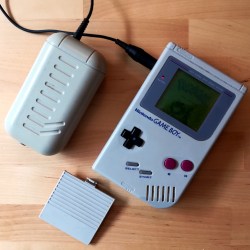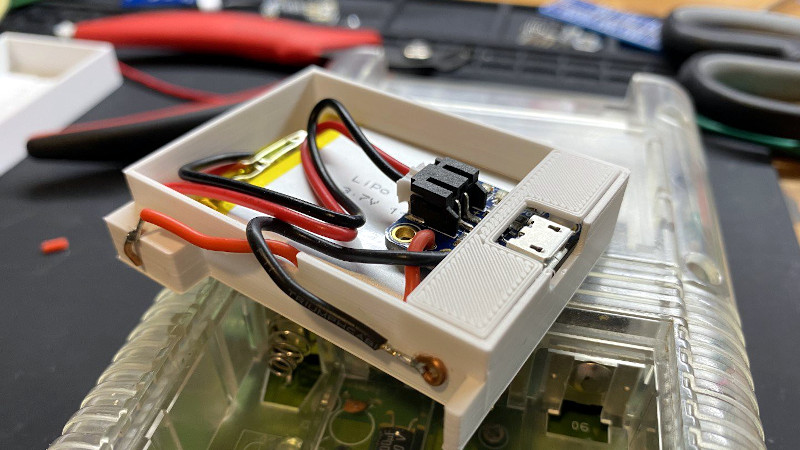Electronic toys of yesteryear were fantastic objects of desire, but came with the fatal flaw of requiring batteries. Batteries that cost more than the average youngster’s pocket money and for which the pestered parent were usually unwilling to fork out every couple of days to support an incessant playing habit. It’s something [Sen] has addressed for the Nintendo Game Boy, and rather than cutting the device up and soldering wires, the result is a unit that neatly slots into the existing 4AA battery enclosure.

Electrically it’s a simple case of wiring up an Adafruit module and a pouch cell, but that’s not the essence of the job in this case. Instead a huge quantity of work and iteration has gone into CAD design to the perfect-fitting pack. It’s sure to be a boon for today’s Game Boy player, but much more than that it should be of interest to owners of far more devices that take four AA cells. Most of us probably keep a few packs of AAs for just those moments, perhaps meanwhile something like this could be a handy thing to have instead.
More traditional conversions resort to extreme measures, as with this Game Boy Color.

















Most devices that runs on 3 or 4 AA can be run on a power bank :)
But a power bank outputs 5V. How can a device working on 4 x 1.5V = 6V run happily on a 3.7V LiOn battery?
I checked the page and he doesn’t use a step up converter as well.
The only device I did a similar mod on was my HP48SX, but that was working on 3 AAA batteries. And I wasn’t surprised that worked because the HP48 could run off NiMH batteries, so 3×1.2V.
Actually, I did this mod on the nipper remote controlled car as well, which was also fitted with a 3 x NiCd batteries pack. But my point is I never thought of trying with a device using 4 batteries, that is w/o a step up converter.
battery operated devices must be able to run on a variety of voltages. a alkaline battery can vary between something like 1.7 to 0.8 volts depending on charge and quality. a lipo is around 4.2 when fully charged. so when fully charged the device will behave like its almost discharged.
so you should be able use the top 20% of the capacity. so not happliy …rather like its on life support :-P
Both alkalines and lipo cells have highly non-linear discharge curves, it’s only when they’re mostly discharged that the voltage drops significantly. As long as the cutoff voltage is at or below the ‘knee’ in the curve, you’ll get to use most of the capacity of the cell, not just “the top 20%”.
It uses cmos technology which run down to 3v.
There is a crude discrete switch mode power supply inside the Gameboy to generate *5V* for the rest of the circuit.
http://www.devrs.com/gb/files/gameboy3.gif
Right, so as I was expecting, the Game Boy running off a 3.7V battery pack is the exception, not the rule. And from what you say, maybe you’d actually be better off using a modern step up converter to crank up the 3.7V to 5V rather than leave the old-maybe-not-so-efficient Game Boy regulator do it for you?
Out of curiosity, I tried a 3340 mAh battery pack on my PM97 scopemeter, and that didn’t cut the mustard for it! In case it’s a current issue (although 3A should be more then enough, it runs from NiMH batteries!), I then tried on my TI-89, and it wouldn’t switch on from it either. Both devices are normally powered by 4 AA/AAA batteries.
That 5V regulator also generate 13V for the LCD bias. It is a flyback regulator that can handle a wider range of inputs, but at the expense of lower efficiency. The battery pack I got actually had only 2 NiCd in it.
Inputting 5V might help the efficiency a bit, but now you have 2 leaks in a boat. :P If I have to do it, I would use a boost mode supply and use a charge pump for the LCD bias.
Ok, so I actually found one device, normally working on 4 AAA batteries, that WILL work from a Li-Ion battery: my kitchen scales! Quite impressed, must be well designed to work from such low voltage… but I’ll have to keep an eye for leaking batteries on this one as the batteries could be closed to be dead when the scales still work!
Does this particular LiPo cell have overdischarge protection? And/or does the game boy stop drawing current before it’s fully discharged?
Yes, all Adafruit pouch cells are protected.
Ah, the original Nintendo ‘Battery Flail’ accessory. I still have mine! (Of course it’s probably been like 20 years since it could hold a charge!)
I don’t know that I could ever do a battery pack for my vintage 1989 Game Brick…I feel like stuffing those four AAs in there is part of the experience…but then, I’m the kind of jackass who steadfastly refuses to run an arcade cabinet on ‘Free Play’ because he loves the sound quarters make going through the coin mech and into the bucket.
My pinball machine doesn’t even have a freeplay option! I’m with you with the AA batteries, especially since everyone has rechargeable lithium AA cells that make the experience a lot less costly. I’m even screwed up enough that I wish my OG battery pack still worked. It even has a belt clip!
Interesting idea, but this implementation is vastly inferior to just 4xAA Eneloops in terms of capacity. The Eneloops would give you 1.2V*2.0AH*4cells = 9.6 Wh (or 12.2 Wh if using Eneloop Pros) vs the 3.7V*1.1AH = 4.1 Wh for this lithium setup. Lithiums could likely win with a more optimized design (2 larger cells in parallel, smaller adapter/electronics so it fits) if you could get it to fit, but as posted it’s a step back.